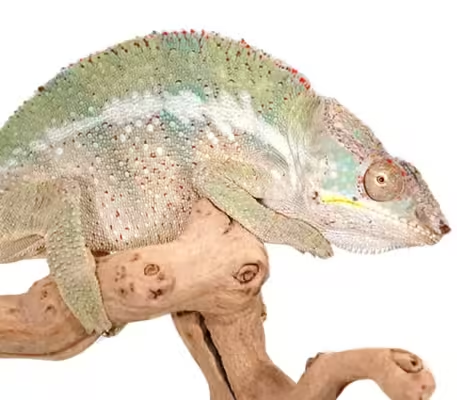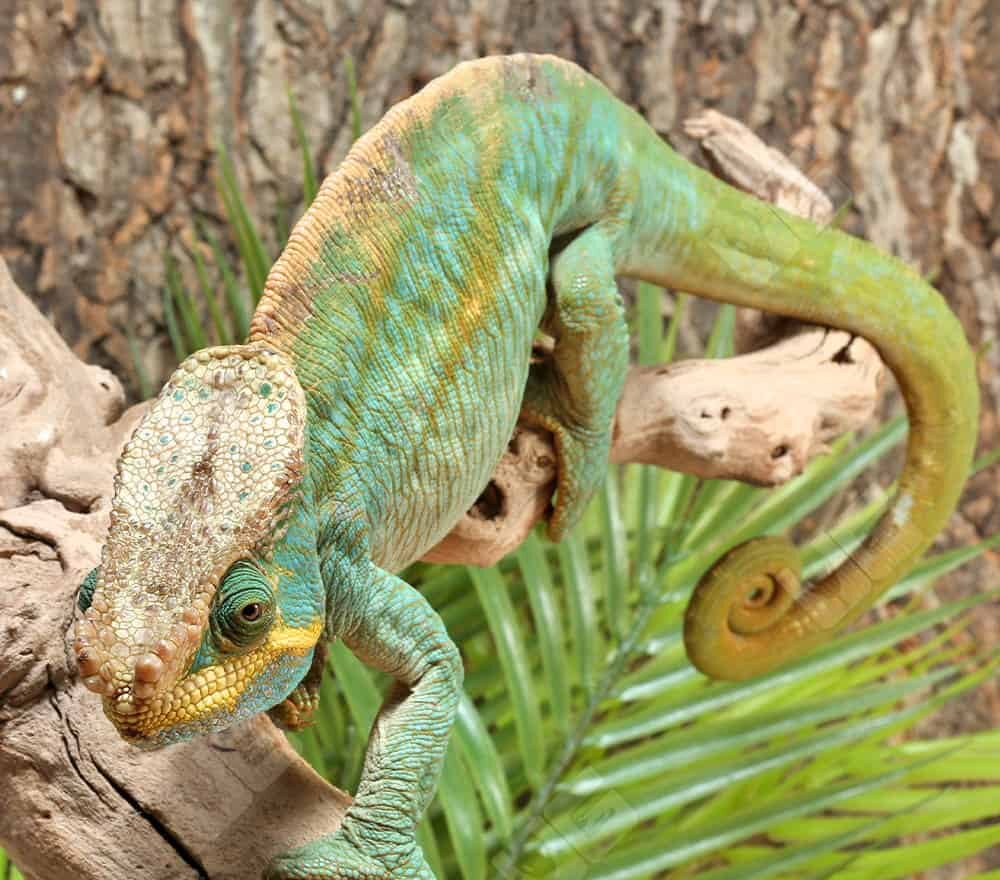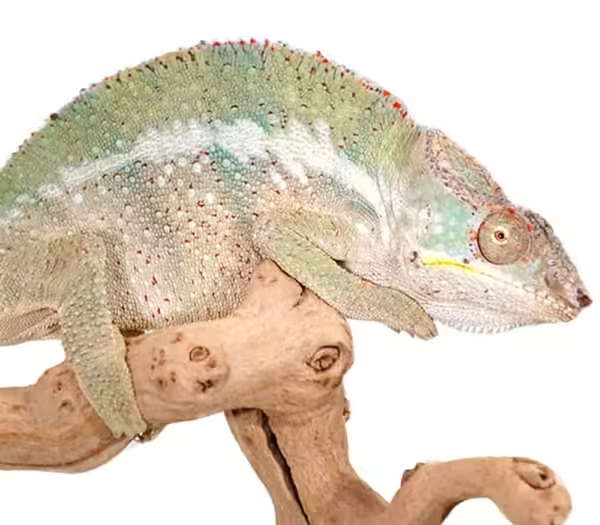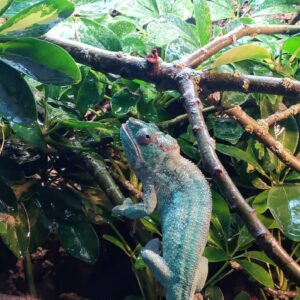Angalovana Panther Chameleon For Sale
$299.99
WE HAVE ANGALOVANA PANTHER CHAMELEON FOR SALE. HERE ARE SOME HIGHLIGHTS:
- Furcifer pardalis
- Field Collected Beauties
- Approximate Sizes Ranging From 14-18 In Length
- Adults Are Averaging Around 13 – 17 Inches In Total Length
- These Are Precision Hunters Feeding On Live Crickets, Super Worms, Roaches, And Other Calcium Dusted Insects
FUN FACTS!
- Originating From Madagascar These Range From The Coastal Central To Northeastern Madagascar
- Rich Green And Aqua Changing Skin With A Lightning Bolt White Stripe Along Its Side These Panthers Are Ferocious In Colors
- With Proper Care They Can Live Up To 2-3 Years
- Chameleons Have A Retractable Tongue That They Are Able To Shoot Out Of Their Mouths Like A Harpoon To Catch Their Prey From A Distance
- Tree Dwellers These Chameleons Have Feet Perfectly Outfitted To Grab Branches And Crawl Upside Down And From Side To Side In Bushes And Trees
Description
The Angalovana Panther Chameleon, scientifically known as Furcifer pardalis, is a remarkable species native to the island of Madagascar. This chameleon has captured the interest of herpetologists and enthusiasts alike due to its vibrant coloration and unique physiological traits. The common name “Panther Chameleon” is derived from its striking appearance, reminiscent of the exotic patterns found on panthers.
Belonging to the family Chamaeleonidae, the Angalovana Panther Chameleon is distinguished by its ability to change colors dramatically. This attribute is not merely for camouflage, but also plays a crucial role in communication, mating rituals, and temperature regulation. The species exhibits sexual dimorphism, with males typically showcasing more vivid colors compared to females, who are generally more subdued in their hues.
What sets the Angalovana Panther Chameleon apart from other chameleon species is its distinct geographical variations. Different regions of Madagascar harbor populations with unique color patterns, ranging from brilliant reds and blues to greens and yellows. These regional color morphs are often named after the specific locales they inhabit, such as the Nosy Be, Ambanja, and Tamatave varieties. This phenotypic diversity makes the Angalovana Panther Chameleon a subject of particular interest in studies of adaptive evolution and speciation.
Understanding the basics of this captivating reptile sets the stage for deeper exploration into its habitat, behavior, and conservation status. As we delve further into the life of the Angalovana Panther Chameleon, we uncover the complexities and marvels that make this species an exceptional representative of Madagascar’s rich biodiversity.
Habitat and Distribution
The Angalovana Panther Chameleon, a captivating species known for its vibrant coloration, is primarily found on the island of Madagascar. This species is endemic to the region, meaning it does not naturally occur anywhere else in the world. Madagascar’s unique and diverse ecosystems provide the ideal environment for the Angalovana Panther Chameleon to thrive.
Within Madagascar, the Angalovana Panther Chameleon predominantly inhabits the tropical and subtropical moist broadleaf forests. These forests are characterized by high humidity and dense foliage, which creates a suitable microhabitat for these chameleons. The lush vegetation offers ample opportunities for camouflage, an essential aspect of their survival strategy, as well as abundant prey in the form of insects.
In terms of geographical distribution, the Angalovana Panther Chameleon is most commonly found in the northeastern regions of Madagascar. Areas such as the Masoala Peninsula and the island of Nosy Be are particularly notable for their significant populations of this species. These regions are known for their rich biodiversity and relatively undisturbed natural environments, which are crucial for maintaining healthy chameleon populations.
Moreover, the chameleons’ habitat preferences extend to specific microhabitats within these forests. They are often found at various elevations, ranging from sea level up to 1,200 meters. The chameleons favor areas with thick underbrush and plenty of branches, which provide the necessary support for climbing and perching. They also prefer locations with consistent access to water sources, such as streams and rivers, which are vital for their hydration and overall well-being.
Conservation efforts are critical to preserving these habitats, as deforestation and habitat fragmentation pose significant threats to the Angalovana Panther Chameleon’s survival. By understanding and protecting their natural environments, we can ensure that these remarkable creatures continue to inhabit Madagascar’s forests for generations to come.
Physical Characteristics
The Angalovana Panther Chameleon is renowned for its striking physical features, which make it one of the most visually captivating reptiles. Typically, adult males can reach a length of 17 to 20 inches, while females are slightly smaller, ranging from 10 to 14 inches. This size difference is one of the first noticeable distinctions between genders. The chameleon’s robust body and prehensile tail are adapted for an arboreal lifestyle, enabling it to navigate the dense foliage of its natural habitat with ease.
One of the most remarkable aspects of the Angalovana Panther Chameleon is its vibrant color palette. These chameleons exhibit a spectrum of colors, including shades of green, blue, red, and yellow. The diversity in coloration is not just between individuals but also within a single chameleon over time. Male chameleons are particularly noted for their bright and varied colors, which are used primarily for communication and courtship displays. In contrast, females often exhibit more subdued tones, such as brown or green.
Color change in the Angalovana Panther Chameleon is influenced by several factors, including light, temperature, and emotional state. The chameleon’s skin contains specialized cells called chromatophores, which adjust the distribution of pigment and enable rapid color transformation. For example, a chameleon might turn a darker shade when exposed to colder temperatures or when feeling threatened. Conversely, during mating displays or territorial confrontations, males can display vibrant, contrasting hues to assert dominance and attract potential mates.
In addition to their color-changing abilities, these chameleons are also characterized by unique markings that can include stripes, spots, or bands. These markings further enhance their camouflage capabilities, allowing them to blend seamlessly into their environment. The combination of size, color variations, and distinct markings makes the Angalovana Panther Chameleon a truly fascinating subject of study for herpetologists and a marvel of nature for wildlife enthusiasts.
Behavior and Diet
The Angalovana Panther Chameleon exhibits a range of fascinating behaviors and dietary preferences that reflect its adaptive strategies in the wild. Primarily a solitary creature, this chameleon is highly territorial, often engaging in displays of color to assert dominance and ward off potential rivals. Males are particularly known for their vivid color changes during territorial disputes and courtship rituals. These displays are not merely for show but are critical for communication and survival in their natural habitat.
During mating season, the behavioral dynamics of the Angalovana Panther Chameleon become even more intricate. Males perform a series of movements and color transformations to attract females, who, in turn, exhibit specific colors to indicate their receptiveness or rejection. These mating rituals are a vivid spectacle and play a crucial role in the continuation of the species.
In terms of daily activity, the Angalovana Panther Chameleon is diurnal, meaning it is active during daylight hours. It spends a significant portion of its day basking in the sun, which is vital for thermoregulation. As ectotherms, these chameleons rely on external heat sources to regulate their body temperature.
The diet of the Angalovana Panther Chameleon primarily consists of insects, which they hunt using their highly specialized tongues. The chameleon’s tongue can extend to twice its body length, allowing it to catch prey with remarkable speed and precision. Common prey includes crickets, locusts, and various insects that inhabit their environment. Occasionally, they may consume small vertebrates or other invertebrates to supplement their diet.
Feeding typically occurs in the morning and late afternoon, aligning with their peak activity periods. The chameleon’s hunting technique relies heavily on stealth and patience, often remaining motionless until the perfect moment to strike. This combination of unique behaviors and dietary habits underscores the complex and captivating nature of the Angalovana Panther Chameleon.
Reproduction and Lifespan
The reproductive cycle of the Angalovana Panther Chameleon is a compelling aspect of its life history, characterized by distinct mating behaviors and reproductive strategies. Typically, the mating season occurs during the warmer months, when males exhibit vibrant color changes to attract females. These striking displays serve not only as a courtship mechanism but also as a means of establishing dominance among rival males. Mating usually involves a series of ritualistic movements and displays, culminating in copulation.
Following successful mating, the gestation period for the female Angalovana Panther Chameleon lasts approximately 20 to 30 days. During this time, the female undergoes noticeable physical changes, including an increase in body size as the eggs develop. Upon completion of the gestation period, the female seeks out a suitable location to lay her eggs, typically preferring a secluded, moist area with loose soil. The number of eggs laid can vary, but it generally ranges from 10 to 40 eggs per clutch.
Once the eggs are laid, they undergo an incubation period that can last from six to twelve months, depending on environmental conditions such as temperature and humidity. The hatchlings emerge fully independent and are immediately capable of fending for themselves, although they are highly vulnerable to predators during this early stage of life.
The lifespan of the Angalovana Panther Chameleon varies significantly between wild and captive environments. In the wild, these chameleons face numerous threats, including predation, habitat loss, and environmental fluctuations, which contribute to a shorter lifespan averaging around three to five years. In contrast, individuals kept in captivity, with optimal care and a controlled environment, can live significantly longer, often reaching up to seven years or more. Proper husbandry, including a balanced diet, appropriate lighting, and habitat enrichment, plays a crucial role in extending the lifespan of captive chameleons.
Conservation Status
The Angalovana Panther Chameleon, a unique and vibrant reptile native to Madagascar, is currently facing significant conservation challenges. Population trends indicate a worrying decline in their numbers, primarily due to habitat destruction. Madagascar’s forests, which serve as the primary habitat for the Panther Chameleon, are under constant threat from deforestation for agriculture, logging, and urban development. As these forests shrink, so does the habitat available for this species, leading to a decrease in population density.
Another pressing threat to the Angalovana Panther Chameleon is climate change. Alterations in temperature and precipitation patterns can adversely affect their delicate ecosystem. Changes in climate can disrupt breeding cycles and food availability, further exacerbating the survival challenges for this species. Moreover, the chameleon’s reliance on specific habitats makes them particularly vulnerable to these environmental changes.
Conservation efforts are underway to protect the Angalovana Panther Chameleon. Various organizations are working on habitat restoration projects, aiming to reforest areas that have been heavily degraded. These initiatives not only provide critical habitat for the chameleons but also benefit the broader ecosystem. Additionally, there are ongoing research and monitoring programs to better understand the population dynamics and ecological requirements of the species, which can inform more effective conservation strategies.
Protective measures also include the establishment of protected areas where the chameleons can thrive without the immediate threat of habitat destruction. Environmental education and community engagement are vital components of these conservation efforts, as local communities play a crucial role in the sustainable management of natural resources. By fostering a sense of stewardship and providing alternative livelihoods, these programs aim to reduce the human pressure on chameleon habitats.
In the face of these challenges, the future of the Angalovana Panther Chameleon hinges on continued and concerted conservation efforts. Protecting this species requires a multifaceted approach that addresses both environmental and socioeconomic factors, ensuring that these remarkable reptiles can continue to enchant future generations.
Caring for Angalovana Panther Chameleons in Captivity
Caring for Angalovana Panther Chameleons in captivity requires a thorough understanding of their unique needs to ensure their well-being. An optimal enclosure is crucial. A spacious, vertically oriented terrarium is ideal, with dimensions no smaller than 24″x24″x48″. This allows ample room for climbing, which is a natural behavior for these arboreal creatures. Ensure the enclosure is well-ventilated and equipped with plenty of branches and foliage to mimic their natural habitat.
Lighting and temperature regulation are key components in maintaining a healthy environment. UVB lighting is essential for calcium metabolism and should be provided for 10-12 hours daily. Temperature gradients within the enclosure should range from 75°F to 85°F during the day, with a basking spot reaching up to 90°F, and a nighttime drop to around 65°F to 70°F. Humidity levels should be maintained between 60% and 80%, which can be achieved through regular misting and the use of a drip system.
Dietary needs of Angalovana Panther Chameleons are specific and must be met with a varied diet of live insects. Crickets, roaches, and silkworms should form the bulk of their diet, supplemented occasionally with waxworms or mealworms. Gut-loading insects with nutritious foods and dusting them with calcium and vitamin D3 supplements are practices that contribute to the chameleon’s overall health.
Healthcare is another critical aspect of keeping Angalovana Panther Chameleons. Regular monitoring for signs of illness, such as changes in appetite, color, or behavior, is essential. Common health issues include dehydration, metabolic bone disease, and respiratory infections. A reptile-experienced veterinarian should conduct periodic health check-ups to catch potential problems early.
Handling Angalovana Panther Chameleons should be minimized as they can be easily stressed. When necessary, handle them gently and support their body fully to avoid causing distress or injury. By providing a well-maintained environment, a balanced diet, and attentive healthcare, you can ensure the well-being of Angalovana Panther Chameleons in captivity.
Interesting Facts and Trivia
The Angalovana Panther Chameleon, a mesmerizing reptile native to Madagascar, has captivated herpetologists and enthusiasts alike with its vivid colors and remarkable adaptability. One of the most intriguing aspects of these chameleons is their unparalleled ability to change colors. Contrary to popular belief, this color change is not solely for camouflage but also serves as a communication tool. Males, in particular, use vibrant hues to assert dominance and attract potential mates, while females might display specific colors when they are gravid or stressed.
Historically, the Angalovana Panther Chameleon has held a special place in Malagasy culture. Indigenous communities often associate these chameleons with good fortune and prosperity. Some local legends even suggest that spotting a Panther Chameleon can bring a person good luck. This cultural reverence underscores the deep connection between the people of Madagascar and their native wildlife.
Another fascinating fact is related to the chameleon’s eyes. Unlike most reptiles, the Angalovana Panther Chameleon’s eyes can move independently of each other, allowing them to have a full 360-degree view of their surroundings. This unique trait not only aids them in spotting predators and prey but also in their complex social interactions.
In the wild, these chameleons have a relatively short lifespan, typically ranging from two to three years. However, in captivity, with proper care, they can live up to five years. This difference in lifespan highlights the importance of habitat preservation and proper care practices to ensure their survival.
Remarkably, the Angalovana Panther Chameleon has also been featured in various forms of media and popular culture. Its distinctive appearance and vibrant colors have made it a symbol of exotic wildlife, often depicted in documentaries, art, and literature. These cultural references further emphasize the chameleon’s enchanting allure and its significance beyond the realm of biology.








